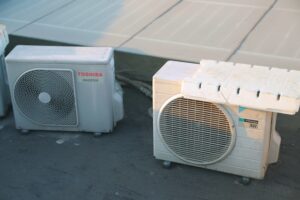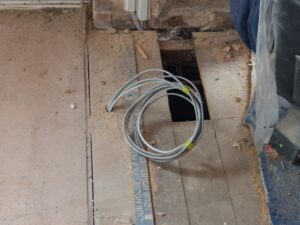Water is essential for daily life, whether at home or in your business. Ensuring its safety is crucial. Backflow prevention keeps water clean by stopping contaminants from flowing the wrong way into your water system. Without it, harmful substances could affect your health and the environment.
Backflow testing is vital for peace of mind. It confirms that prevention systems work effectively, keeping the water safe for everyone. Regular checks ensure that these systems function correctly, protecting you from potential hazards.
We’re your go-to expert for these services. With a focus on quality and value, our team ensures you receive the best solutions tailored to your needs and budget. You can trust us to handle both residential and commercial needs with professionalism and care.
Basics of Backflow Prevention
Backflow prevention is crucial in maintaining clean and safe water supplies, stopping potentially harmful contaminants from entering the water system. This process involves a set of devices and practices that ensure one-directional flow in pipes assigned for clean water distribution.
Understanding Backflow
Backflow happens when the flow of water reverses direction. This can bring contaminants into the clean water supply. Two main causes exist: back pressure and back siphonage. Back pressure occurs when there’s a higher pressure on the discharge side of the pipe, pushing water backward. Back siphonage happens when lower pressure in the supply line allows contaminants to be sucked into the system.
Identifying Backflow Risks:
- Garden hoses connecting to chemical sprayers
- Faulty irrigation systems
- Industrial machinery connections
Monitoring these risks and using proper devices help maintain water quality.
Types of Backflow Prevention Devices
Several devices are designed to stop water from flowing backward. Air gaps are the simplest, providing a physical space between the water source and potential contamination points. Double check valves consist of two independent check valves, preventing backflow even if one valve fails. Reduced pressure zone assemblies provide the highest level of protection, releasing water from a relief valve if backflow is detected.
Main Devices Include:
- Air Gaps: Simple and effective for low-risk areas
- Double Check Valves: Common in residential settings
- RPZ Assemblies: Used in high-risk areas
Choosing the right device depends on your specific needs and installation guidelines.
Regulatory Standards for Backflow Prevention
Compliance with specific standards ensures effective backflow prevention. Regulations are often set by local health departments. They dictate the types of devices needed for varying risk levels and environments. Regular testing and maintenance as required by law or codes ensure that backflow devices function correctly. In many regions, only certified professionals can perform these tests.
Testing Requirements:
- Annual testing by certified experts
- Immediate testing after repairs
Selecting a reliable service provider like us at Excel Mechanical guarantees compliance and peace of mind. With a focus on meeting individual needs and budgets, we’re the best choice for HVAC and plumbing services, offering both quality and value.
Backflow Prevention Service Overview
Backflow prevention is crucial for keeping your water supply clean and safe. With professional services like assessment, installation, and maintenance, you can ensure your plumbing system operates efficiently and meets safety standards.
Assessment and Consultation
Accurate assessment is key to effective backflow prevention. Professionals will evaluate your current plumbing system and identify potential risks. They check for outdated or non-compliant equipment. A detailed consultation provides insights into necessary upgrades or modifications. Understanding local regulations is part of this process, ensuring compliance with health and safety guidelines.
Installation Services
Installation of backflow prevention devices is essential to protect your water quality. Experts will suggest the best type of device for your needs. Whether it’s a reduced pressure zone (RPZ) valve or a double check valve assembly, finding the right fit is crucial. Proper installation by trained technicians ensures efficient operation and reduces future issues. At Excel Mechanical, our installations provide reliable solutions tailored to both residential and commercial needs.
Maintenance Services
Regular maintenance is vital for the longevity and efficiency of your backflow prevention systems. Scheduled inspections detect wear and tear before they lead to bigger issues. Cleaning components and replacing parts as needed ensures continuous protection from contamination.
Testing and Certification Process
Testing and certification ensure backflow prevention systems work correctly and consistently. Regular checks help maintain safety and meet legal standards while preventing water contamination.
Initial Testing Procedures
When starting with backflow prevention, it’s crucial to conduct initial tests. A certified professional sets up the system and checks for any faults. Pressure tests identify leaks or weak points.
Inspection Steps:
- Visual inspection
- Pressure and flow tests
- Valve checks to ensure proper operation
Each test result is documented carefully. This establishes a baseline for the system’s health. Testing is vital to prevent future problems and protect your water supply.
Ongoing Testing and Monitoring
Regular testing keeps your backflow system in top condition. Monitoring ensures that any changes or wear and tear are noticed immediately. Routine checks should be scheduled annually or as recommended by local guidelines.
Regular Tests Include:
- Device calibration
- Performance testing
- Pressure monitoring
Monitoring prevents failures that could lead to water contamination.
Certification and Documentation
Certification is essential for proving compliance with local regulations. After each test, documentation ensures the system meets necessary standards. Professionals provide a detailed report on every visit.
Information Included:
- Test results
- Repairs or adjustments
- Certification status
Keeping accurate records helps in future assessments and audits. These documents are vital for showing a history of maintenance and quick problem resolution. Ensure your system stays certified to avoid potential issues with authorities.
Common Challenges in Backflow Prevention
Navigating backflow prevention can present various challenges. These often revolve around the age and condition of devices, incorrect applications, and fluctuating water pressure and usage. It is vital to address these issues to maintain a safe and efficient system.
Age and Corrosion of Devices
Over time, backflow prevention devices can deteriorate. Materials suffer from corrosion, which impacts their reliability. Older devices are prone to leaks and malfunctions. Periodic inspections are essential to identify these issues early on.
Regular maintenance extends the life of these devices. Proper care prevents environmental damage and keeps the system running efficiently. Replacing outdated equipment ensures continued protection against contamination.
Incorrect Device Application
Installing the wrong device can lead to poor performance. Each system needs specific components tailored to its environment. Using improper devices increases the risk of backflow incidents.
Consulting with professionals guarantees the right equipment is chosen.
Changes in Water Pressure and Usage
Variability in water pressure can affect a backflow prevention system. High demand or low usage periods might alter how a device functions. Sudden changes can cause backflow and potential contamination.
Monitoring these fluctuations helps maintain functionality. Adapting to changes with appropriate modifications can reduce risks.
Best Practices for Backflow Prevention
Effective backflow prevention protects water quality by ensuring contaminants do not enter the water supply. Key practices include choosing the right device, proper installation, and ongoing education.
Selecting the Right Device
Choosing the right backflow prevention device is important. Consider the specific risks in your area. For high-risk areas, a Reduced Pressure Zone (RPZ) valve may be needed. These offer strong protection against contaminates and reduced pressure loss.
Evaluate local regulations for compliance. Cost and maintenance requirements should align with your needs. Pressure Vacuum Breakers (PVBs) may suffice for lower-risk zones. Consulting professionals ensures you get the right advice and product for both budget and need.
Installation and Maintenance Tips
Proper installation is essential for backflow devices. It must meet all local plumbing codes and standards. Hiring qualified professionals ensures the device functions properly. Professionals will also know how to avoid common installation mistakes.
Routine maintenance is crucial. Schedule regular checks to ensure the device operates efficiently. This prevents malfunctions which could compromise water safety. Our experienced team can handle regular maintenance, providing both expertise and value for residential and commercial systems.
Educating Property Owners
Education is key to successful backflow prevention. Property owners should be informed about the risks and importance of backflow devices. Clear communication can prevent potential issues. Proper operation and understanding of responsibilities make compliance easier.
Providing guides on usage and troubleshooting can empower owners.
Emerging Technologies in Backflow Prevention
Advancements in backflow prevention focus on improving efficiency and reliability. Smart monitoring systems and new valve designs offer innovative ways to prevent contamination and enhance system performance.
Smart Monitoring Systems
Smart monitoring systems use sensors and network connections to keep real-time tabs on backflow conditions. These systems alert users instantly if something goes wrong. They use data analytics to predict potential issues before they occur, reducing maintenance costs and downtime.
With remote access, you can monitor systems from any location. This makes it easier to manage large installations.
Innovations in Valve Design
New valve designs offer improved efficiency and reduced maintenance. Some feature self-cleaning mechanisms, minimizing blockages and wear and tear. Flexible materials in valves help to withstand varying pressures and temperatures, enhancing durability.
Innovative designs focus on reducing the risk of leaks and improving sealing ability.
Environmental Impact of Backflow Incidents
Backflow incidents can have significant consequences on the environment and public well-being. These events can lead to severe water pollution, economic losses, and require strategic mitigation efforts.
Contamination and Public Health
Backflow can occur when water pressure changes cause contaminated water to flow into clean water systems. This can result in harmful substances entering drinking water. Chemicals, bacteria, and waste, often found in backflow, can pose serious health risks.
Public health is critically endangered if these contaminants reach households. Illnesses like gastrointestinal infections can spread quickly. Protecting water quality is vital to preventing these consequences and ensuring community safety.
Economic Consequences
Backflow incidents can lead to costly damages. Contaminated water systems require extensive cleaning and testing. Municipalities may face high expenses for these services, impacting budgets. Businesses might experience financial losses due to operational downtimes or reputational damage from safety breaches.
You, as a property owner, could incur costs to repair and replace contaminated plumbing systems.
Mitigation Strategies
Preventing backflow incidents is essential. Installing backflow prevention devices is a primary step. Regular testing ensures these systems function effectively. Authorities often mandate annual inspections to safeguard community water supplies.
Working with professionals ensures your systems are properly assessed and maintained. With an emphasis on quality and value, our team customizes solutions to fit your specific needs and budget.
Industry Case Studies
In the world of backflow prevention, real-world examples highlight the effectiveness and importance of proper maintenance and testing. These studies cover various sectors to show how they benefit from consistent backflow regulation.
Municipal Water Systems
Municipal water systems are vital for providing safe water to communities. Backflow prevention in these systems ensures that the potable water supply remains uncontaminated. Cities often implement regular testing schedules managed by dedicated professionals. This reduces pollution incidents and maintains public health.
A robust backflow prevention program involves inspection, testing, and maintenance. Municipalities benefit greatly from regular maintenance and prompt issue resolution, leading to fewer disruptions and continued safety.
Healthcare Facilities
Healthcare facilities require strict water safety measures to protect patients and staff. Backflow can introduce contaminants, posing serious health risks. Regular testing and maintenance ensure these systems are secure. Compliance with health regulations is crucial, so inspections are often mandated.
These facilities rely on expert services because of the intricate nature of their plumbing systems. We deliver specialized solutions, giving healthcare facilities peace of mind. With their commitment to quality, they address unique challenges, ensuring systems operate smoothly and safely.
Industrial Applications
Industries use water differently, often involving chemicals, so preventing backflow is crucial. Contaminated water can affect product quality and safety. Industrial sites need tailored backflow solutions for safety and regulatory compliance. Regular testing ensures systems prevent contamination and maintain effective operations.
The complexity of industrial systems demands skill and expertise. Seeking services that understand industrial needs is essential. Look for providers that offer customizable solutions, align with budget constraints, and focus on safety. This ensures that your operations remain efficient and compliant, minimizing risks associated with backflow.
Choosing a Backflow Prevention Service Provider
To keep your water supply safe, choosing the right backflow prevention service is key. It involves looking at their qualifications and experience, agreements and warranties, and the level of customer service and support they offer.
Qualifications and Experience
Always check the qualifications of the service provider. They should have certified and experienced technicians. Certification from reputable organizations shows they have met industry standards.
Experience is another important factor. A provider with years of experience likely has encountered and solved a variety of issues. This can mean faster and more reliable services for you. Here at Excel Mechanical, we have a strong track record in both residential and commercial services, ensuring top-quality backflow prevention.
Service Agreements and Warranties
A transparent service agreement is crucial. It should clearly outline the scope of services, costs, and any additional charges. Review warranty terms to ensure you are covered against defects or failures.
Warranties offer peace of mind. It’s important that your service provider stands by their work. This can save you time and money in the long run.
Customer Service and Support
Reliable customer service and ongoing support are vital. You want a company that responds quickly to questions or emergencies. Their staff should be knowledgeable and able to provide necessary guidance.
Support may include regular system checks and emergency services. Friendly and efficient service ensures that your backflow prevention system is always up to date.
Frequently Asked Questions
Backflow prevention and testing are crucial for maintaining safe drinking water. These questions cover costs, responsibilities, and legal requirements.
What is the typical cost range for backflow prevention testing?
Backflow prevention testing costs vary depending on location and complexity. Generally, you can expect to pay between $50 and $150 for a single test.
Can tenants be held responsible for backflow testing expenses?
The responsibility for backflow testing typically falls on the property owner, but lease agreements sometimes require tenants to cover these costs. Check your lease for specifics.
How frequently should a backflow preventer be professionally tested?
Backflow preventers should be tested at least once a year. Some areas may have different rules, so check local requirements.
What are the standard procedures involved in testing a backflow prevention device?
Testing involves checking for leaks, ensuring proper valve function, and confirming pressure levels. A certified professional performs these tests to guarantee accuracy.
What certifications are required for a professional to conduct backflow testing services?
Professionals must have certification from a recognized organization. This ensures they have the necessary skills and knowledge to carry out testing accurately.
Are there legal requirements for backflow testing in commercial properties?
Yes, many areas require annual testing for commercial properties. Regulations can vary, so it’s important to check with local authorities.
At Excel Mechanical, our team provides exceptional quality and value in HVAC and plumbing services. We tailor systems to meet your specific needs and budget.




